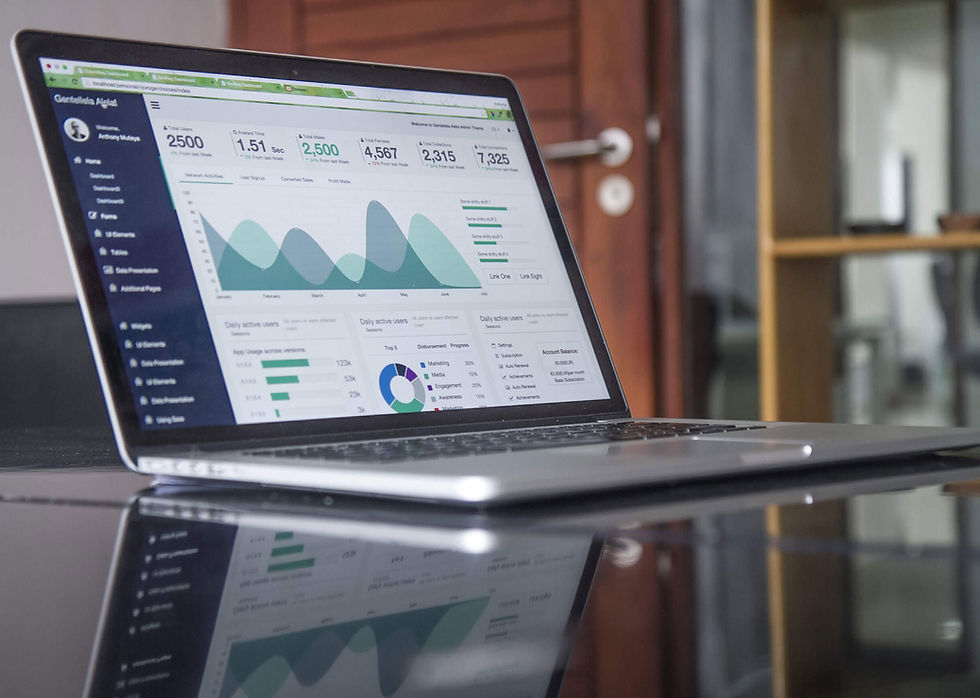The Ultimate Guide to Digital Marketing for Small Businesses
- Adam Mohammed

- Aug 15, 2024
- 4 min read
Updated: Oct 9, 2024

Main Topics Covered:
Introduction to Digital Marketing for Small Businesses
Importance of Digital Marketing
Fundamentals of SEO (On-Page, Off-Page, Technical)
Social Media Marketing Strategies
Email Marketing Best Practices
Paid Advertising (Google Ads vs. Facebook Ads)
Measuring Success with Analytics
Introduction
In today’s fast-paced digital landscape, small businesses are no longer just competing with the shop down the street; they’re competing on a global scale. Whether you're a local café or an online retailer, digital marketing is no longer optional—it’s essential. This comprehensive guide is designed to help small business owners like you navigate the world of digital marketing, offering actionable insights to grow your online presence and attract more customers. This article teaches strong Marketing strategy for startups and provides a great Digital marketing framework.
What is Digital Marketing and Why is it Important?
Digital marketing encompasses all the efforts you make online to promote your business. This includes everything from your website to your social media channels, and even your email campaigns. But why is it so crucial?
Here’s the deal: Over 80% of consumers research a product or service online before making a purchase decision. If your business isn’t visible online, you’re missing out on a huge chunk of potential customers. The goal of digital marketing is to get your business in front of those eyeballs, ensuring that when someone searches for a service you offer, your business is the one they find.

The Fundamentals of SEO
1. On-Page SEO: Building a Strong Foundation
On-page SEO refers to the tactics you can use directly on your website to improve its search engine ranking. This includes optimizing content, meta tags, and internal links. Start by ensuring that each page of your site is optimized for specific keywords related to your business. For example, if you’re a bakery, you’ll want to target keywords like “best bakery in [Your City]” or “custom cakes [Your City].”
Quick Tip: Use tools like Yoast SEO or Rank Math for WordPress to help optimize your content easily.
2. Off-Page SEO: Boosting Your Authority
Off-page SEO is all about increasing your website’s authority and trustworthiness in the eyes of search engines. This is largely achieved through backlinks—links from other reputable websites pointing to your site. You can build backlinks by guest blogging, creating shareable infographics, and getting listed in local directories.
Pro Tip: Focus on quality over quantity when it comes to backlinks. A few high-authority links will do more for your rankings than dozens of low-quality ones.
3. Technical SEO: Ensuring a Smooth User Experience
Technical SEO refers to non-content-related elements of your website that affect its performance in search engines. This includes site speed, mobile-friendliness, and secure connections (HTTPS). A slow, clunky website will not only frustrate visitors but also rank lower in search results.
Action Step: Use tools like Google PageSpeed Insights to analyze and improve your website’s speed.
Discover more in this post about Understanding SEO: A beginner's guide to search engine optimization

Social Media Marketing: Connecting with Your Audience
Social media platforms are where your customers are spending their time. But it’s not enough to just be present; you need to engage and provide value. Whether it’s through Facebook, Instagram, Twitter, or LinkedIn, each platform offers unique opportunities to connect with your audience.
Choosing the Right Platforms
Not all social media platforms are created equal. It’s important to choose the ones where your target audience spends their time. For instance, Instagram is ideal for visual content and engaging younger audiences, while LinkedIn is perfect for B2B marketing and networking.
Content Planning and Scheduling
Creating consistent, high-quality content is key. Plan your content in advance and use tools like Buffer or Hootsuite to schedule your posts. This ensures you’re consistently reaching your audience without the daily grind of posting.
Discover more in this post about How to Start Social Media Marketing for Small Businesses

Email Marketing: Nurturing Leads and Building Loyalty
Email marketing remains one of the most effective ways to reach your customers directly. With a well-crafted email strategy, you can nurture leads, build customer loyalty, and drive conversions.
Building an Email List
Your email list is one of your most valuable assets. Start building it from day one by offering something valuable in return—like a discount code or a free eBook. Use tools like Mailchimp or ConvertKit to manage your list and automate your campaigns.
Crafting Effective Email Campaigns
When crafting your emails, focus on delivering value rather than just promoting your products. Share tips, behind-the-scenes content, and exclusive offers to keep your audience engaged.
Discover more in this post about Mastering Email Marketing: Strategies to build and nurture a high quality email list

Paid Advertising: Accelerating Your Growth
Organic growth is great, but sometimes you need to give it a little boost. Paid advertising allows you to target your ideal customers with precision, driving traffic and conversions quickly.
Google Ads vs. Facebook Ads
Both platforms offer powerful advertising options, but they serve different purposes. Google Ads is ideal for capturing intent—when someone is actively searching for what you offer. Facebook Ads, on the other hand, are great for building awareness and targeting specific demographics.
Discover more in this post about Paid Advertising: Accelerating your Growth with Google Ads and Facebook Ads

Analytics: Measuring and Optimizing Your Efforts
You can’t improve what you don’t measure. That’s where analytics come in. Regularly tracking your performance will help you understand what’s working and what’s not, allowing you to optimize your strategy. It is important to have Data-driven marketing strategies to help your business grow.
Key Metrics to Track
Website Traffic: How many people are visiting your site?
Conversion Rate: How many visitors are turning into customers?
Engagement Rate: How are people interacting with your social media content?
Use tools like Google Analytics and Facebook Insights to track these metrics and more.
Conclusion: Taking Your Digital Marketing to the Next Level
Digital marketing is a marathon, not a sprint. It takes time, effort, and consistent optimization to see results. But with the right strategy in place, you can grow your small business, attract more customers, and ultimately achieve your business goals.
Ready to take your digital marketing to the next level? Subscribe to the AMUK Media blog for more expert tips, or contact us today to see how we can help you succeed.
Contact us today AMUK Media is a great place for The Best Digital marketing strategies 2024.





Comments